Dark Matter: A Massive Mystery
Are we on the verge of solving one of the longest standing puzzles in physics? Physicists think we're close to discovering the identity of Dark Matter, the mysterious, invisible substance that accounts for nearly a quarter of the mass of Universe. So how will scientists see it, and why does its discovery matter? Plus, genes for pain, how smartphones can save lives, whether babies can feel pain, and how to make tastier cheese...
In this episode
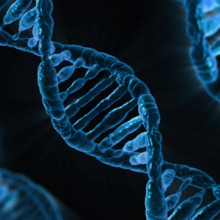
00:58 - The end of pain? Pain gene discovered
The end of pain? Pain gene discovered
with Geoff Woods and Alva Chen, University of Cambridge
A group of extremely rare individuals, who can't feel pain, have helped scientists to uncover an important gene - catchily called PRDM12 - that controls the formation of pain nerves in the developing body, and also their function in the adult nervous system. The discovery was made by Alva Chen and her colleague, Geoff Woods. They told Chris Smith about the breakthrough...
Geoff - For a long time, we've been studying people who don't feel any pain. Either they're born not feeling pain or over the course of the first couple of years of life, they'd lose the ability to feel pain. And we've been very surprised that no one researches this area and we've been trying to find people with the condition and then find the genetic basis of their condition.
Chris - When you say they don't feel pain, are we saying they could literally put their hand in boiling water and they wouldn't know?
Geoff - Yes, that's quite right because they have senses such as touch and temperature sensation, but they wouldn't know when hot water was becoming painfully and dangerously hot. They'd just think it was hot water.
Chris - What do they think about that experience? They must know it's abnormal.
Geoff - They learn it's abnormal because everyone is so worried about their behaviours and the fact that they get damaged which they eventually realise is dangerous to their well-being. But for quite a while, they're completely perplexed by why everyone else is upset and can't put their hands in places they can put their hands, fall over and not hurt themselves. And so, there's a time where they're extremely clumsy because they'll just bash into things, fall over and not care. And they suddenly get it that other people feel pain and they've got to pretend to feel pain and emphasise that other people feel pain.
Chris - Alva, how many patients did you study?
Alva - We studied over 160 patients and we compared their genetic component to 20,000.
Chris - I see. So, you have this group of people who have this trait. They don't have the pain. You're comparing them letter by letter genetically with a very, very large group of people from the general population to see if there are differences in the people who have the syndrome that keep coming up that are not present in the big group of normal people.
Alva - Yes, essentially. So, we're comparing the genetic sequence of the affected patient to the healthy individual and found that a gene called PRDM12, they all have mutation in this gene.
Chris - That has the effect of damaging or altering the way the gene works.
Alva - The mutations in the gene certainly damage the protein that is produced.
Chris - So, it can't do its job properly. Jeff, what are the implications of what you found?
Geoff - PRDM12 is quite extraordinary in that it's the most specific gene for pain neurons that yet has been found. It's not expressed in any other type of cell. If you can work out what it's doing and either augment it or block it, you should have a pain-specific treatment. The next feature of the gene which is exciting is that it's involved in the early development of pain neurons. Then its expression decreases and then it comes back again on in mature pain neurons. So, that would make you feel that it must have a postnatal role, either in making pain neurons healthy or in supressing pain. And so, the next role Alva will be involved with is trying to find out what is the role of this gene postnatally in normal people and in people with pain. Now, if it's involved in programming genes in pain neurons which was essential for their function, if you could block that process, maybe you could either deactivate the pain neuron or you can make a pain neuron become healthy or in fact, you could shut off a pain neuron by control of this. So, there's potential here for treating painful conditions arising from extremely rare people who don't feel pain.

04:57 - Could smartphones diagnose your illness?
Could smartphones diagnose your illness?
with Peter Cowley, Entrepreneur and Angel Investor
The mini, personalised computers that are smartphones have revolutionised the  modern world. We're now more connected than ever before and, increasingly, thanks to the huge variety of applications available for download, we can enhance the capabilities of these devices way beyond being just a phone. Technology investor Peter Cowley explained to Graihagh Jackson just how big an impact this could make on the healthcare sector...
modern world. We're now more connected than ever before and, increasingly, thanks to the huge variety of applications available for download, we can enhance the capabilities of these devices way beyond being just a phone. Technology investor Peter Cowley explained to Graihagh Jackson just how big an impact this could make on the healthcare sector...
Peter - If you take a modern smartphone which is really a computer with a phone attached to it, there are a huge number of sensors in it. There's over a dozen sensors in there already. Not all of them are relevant of course to health applications, but things like the microphone, if we want to listen to our voice, there are temperature sensors in some of them. More modern ones have got means of measuring heart rate etc. So, if you take the number of sensors in there already, there's already an amount of data that can be derived from the phone. The phone is then connected of course to the cloud and that data can then be analysed by and then passed on to other people.
Graihagh - And it's not just the apps that we can download in the sensors that are already within our phones. There's actually stuff that we can plug on to our phones and enhance that even further.
Peter - Yes. There's an amazing number of sensors one can plug in - a glucose meter for instance if you're diabetic to save carrying around another device because it's built into your phone. There's a blood pressure monitor cuff. There's even an ultrasound device which when plugged in, really just to possibly check one's unborn baby.
Graihagh - So, you could just plug this into your phone via say, the volume port or even the charge port and get the ultrasound up and look at the baby in real-time. That's incredible!
Peter - Exactly, using the charge port. Yes, there was a little start up that I saw based at Slovenia that's now based in California that won a prize in Vienna recently. The device I brought in with me today is actually ECG. So, this detects the heart rate and also the electrical impulse of the heart. This plugs onto the back of the phone. It generates, turns the electrical signal into sound and then goes through the microphone on the phone. As you can see that my heart rate is even higher than it was earlier.
Graihagh - I was going to say, it was 98 before. It's now 115. So, you're obviously feeling a little bit nervous.
Peter - Yes. It's stressful being in front of a live microphone. You radio professionals don't seem to have that problem. But the important thing is you can see the wave form of the heart. Now, I can't interpret that. I'm not a medic, but I can then take a snapshot of that and send it to my heart surgeon who can then say, "Fine. Peter, you're okay" or "Please come and see me."
Graihagh - So, that's now, and these things are all available now, but what can we be looking forward to in the future?
Peter - In the near term, the big that's going to be coming into our high end phones which will gradually work its way down is a type of gas sensor. So, it's monitoring a whole variety of gases from carbon monoxide, possibly for situations where there's gas leak from a fire, carbon dioxide, volatile organic compounds. Now, these are very complex set of things like aldehydes and ketones, and hydrocarbons. The important thing there is air quality. So imagine going for a run in the summer in a polluted city and your phone telling you where to run and where not to run based on the quality of the air there.
Graihagh - Wow! That's quite something. All these monitoring, we're doing a lot of it already. What's the benefit? Why do we actually want to do this other than just say, a bit of personal interest I guess?
Peter - Yes, this goes for tech and early adopters. Two things really - one is the so-called quantified self where we weighed ourselves for a while, we've checked our calorific spend, we're also getting to the point where we want to measure other things like blood pressure and heart rate, etc. Medical profession would benefit a lot from having that data. Once it can be clinically proven that a data is correct, having that data so we don't have to continually visit our GPs to have tests done. So that our mobile devices will then in the end potentially predict when we should go and even book the appointment with one's GP actually if we look forward 10 or 20 years.
Graihagh - And you say, when they're clinically proven to be accurate, does that mean they're currently not accurate and there are ongoing trials to see whether they are accurate enough to be used as a diagnostic tool?
Peter - That's a very complex question. The point between taking some data and making it clinically usable it's going to be a while before the medical profession will believe the sensors will be good enough to use instead of the devices they've got inside the hospital. But it's a precursor to that which will then warn to the point where you can have test done internally in the hospital. But go forward 5 or 10 years, there's no reason why we shouldn't get that far.
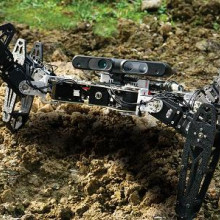
09:19 - A robot that can't be stopped
A robot that can't be stopped
with Professor Jeff Clune, University of Wyoming
Robots are beginning to play a major part in our lives. They can venture into 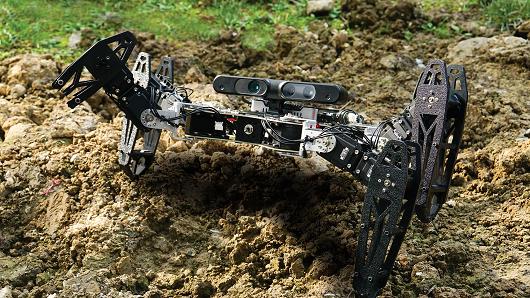 places too dangerous or too toxic for a human to do things like search and recovery, chemical cleanups or fire-fighting. But, at the moment, robots are inherently limited by a poor ability to cope when something goes wrong. Now that could be about to change, thanks to a breakthrough by US and French researchers who have developed a revolutionary programming algorithm to make robots "learn like we do". Jeff Clune is one of the team and he spoke to Chris Smith...
places too dangerous or too toxic for a human to do things like search and recovery, chemical cleanups or fire-fighting. But, at the moment, robots are inherently limited by a poor ability to cope when something goes wrong. Now that could be about to change, thanks to a breakthrough by US and French researchers who have developed a revolutionary programming algorithm to make robots "learn like we do". Jeff Clune is one of the team and he spoke to Chris Smith...
Jeff - So, robots will eventually provide tremendous benefit to society especially if we can have them do work that's too dangerous for humans to do, such as putting out forest fires or finding survivors after an earthquake. But they won't be very useful until they can continue to work if they become damaged. So, what we wanted to do in this work is have robots be able to soldier on and continue to do what we've asked them to do even if they become damaged. So, that requires some creative artificial intelligence techniques that we invented.
Chris - Why can't a robot be made to do that currently?
Jeff - Either you could programme a robot ahead of time to execute a very specific sequence of actions, but then when it becomes damaged then that programme no longer works, or you could try to have the robot learn no its own how to adapt to damage but previous techniques have searched through the entire space of possible behaviours, and in our case, that's more molecules than there are on planet Earth. So, what we need was an intelligent way to quickly adapt what you do, or maybe your dog does, when you become damaged as opposed to something that takes hours or days or years sifting through possibilities.
Our approach is very different. We provide the robots with a simulated childhood if you would, where they get to play around in a computer kind of virtual world and learn all the different ways of their bodies work and how to behave. And when they become damaged, they then use those intuitions that they gained during their childhood to figure out a behaviour that works very well despite the damage. So for example, when you were a kid, you probably learned how they walk around on your tiptoes or maybe only walking using your heels or crawling on floors. If suddenly you found yourself with a wound in your heel out in the forest, you'd say, "Right. I'll just pop up onto my tiptoes. I know how to walk that way because I've practiced it before and that allows me to continue on with my hike or get out of the forest and back to a hospital."
Chris - So, how does the algorithm know which of these solutions to apply under which circumstance and how does it find that solution quickly? Because it will have just a huge database of information relevant to, "I can walk on my tiptoes. I can do handstands"? How does it know which one to apply when?
Jeff - Right. So it actually acts very much like a scientist. It has some predictions from its experience about which behaviours will work well, but it doesn't yet know which of those behaviours will work now that it has this new damaged body. And so, it conducts one experiment and tries something out, it gets the data back from the experiment and then it updates kind of its predictions about what it thinks is going to work. So, if the thing it just tried doesn't work at all, and the thing it just tried relies predominantly on the front three legs, it will say, "Okay, I'm going to rule out that entire family of walking behaviours. Let me try something completely different, maybe something that only uses the back three legs." It tries that out, maybe that doesn't work, so it tries something that only uses the front right and the back left. And it says, "Oh! That works just fine and it's off to the races."
Chris - When you say that you are provisioning these robots with a simulated childhood, how did you do that?
Jeff - So, we make a copy of the robot in a virtual world. Basically, you can imagine kind of a video game avatar of yourself or this robot. And then we encourage the robot in this virtual world to play around and try to find the best way to behave. So, we might say, "Try to find the fastest way of walking only on these three legs or only on those three legs or without using your front right leg." One funny story is that we challenged it to try to walk without ever touching any of your feet to the ground which of course, we thought it couldn't do. But it's very creative and surprised us and actually, flipped over under its back and crawled in its elbows quite rapidly without touching any of its feet to the ground.
Chris - Good grief! I mean, that really is intelligence, isn't it?
Jeff - It certainly is a form of artificial intelligence. We find it very creative, very surprising, and oftentimes can come up with solutions you never would've dreamed of.

14:06 - A sound way to make tastier cheese
A sound way to make tastier cheese
with Dr Tom Leong, Swinburne University
Making the best cheese requires milk from which the cream has been skimmed off.  But waiting for the cream to rise to the top naturally can take hours, and even then some larger globules of fat remain behind, which can make the cheese less tasty. Now, scientists in Australia have discovered that a blast of high-frequency sound waves can make the separation process happen much more rapidly, and result in a superior product. Swinburne University's Tom Leong told Graihagh Jackson how it works...
But waiting for the cream to rise to the top naturally can take hours, and even then some larger globules of fat remain behind, which can make the cheese less tasty. Now, scientists in Australia have discovered that a blast of high-frequency sound waves can make the separation process happen much more rapidly, and result in a superior product. Swinburne University's Tom Leong told Graihagh Jackson how it works...
Tom - Traditionally, we use the process called natural separation to remove the cream from milk and essentially what this is is we leave milk in a bucket and naturally, the cream will rise to the surface and we just collect it off. However, this is a very slow process requiring several hours. This is not feasible for large cow production. So today in the dairy industry, what we use is a machine called the centrifuge. What this does is that we spin milk at a very, very fast rate, several thousand times faster than the speed of gravity. This pulls out all the fat from your milk in a very, very fast timescale in the order of seconds to minutes.
Graihagh - That sounds like a pretty efficient method. What was wrong with this method that you then decided to go away and devise another?
Tom - One potential issue is that when we use a centrifuge, we rip out all the fat. So, what we will have remaining is very, very skim. And so, in order to make 3% fat milk you have to take a portion of this cream and put it back in.
Graihagh - Okay, I see. So, all milk is skinny milk if you like, no fat and then to make the semi-skim milk, you just have to go and put a load of fat back in it. So, it's a bit inefficient essentially.
Tom - Yes. So, one of our motivations was to have a technique where we could pretty much dial in a composition that you wanted. Let's say, 2% fat milk, you put it in and your process would spit that out without having to restandardise. And so, the technique that we're interested in using is applying soundwaves to speed up the rate of which natural separation occurs.
Graihagh - You say you're using soundwaves to do this. So, if we were to put our voices and channel it through the milk, would my voice produce a low fat milk or is it not quite as simple as that?
Tom - It's not quite as simple as that so the soundwaves that I'm talking about are actually, ultrasound waves. These oscillate at say, millions of times per second. The voice is tens to hundreds of oscillations per second. So, we're actually several orders of magnitude higher in terms of frequency.
Graihagh - There was me thinking that we could create a Naked Scientists cheese but...
Tom - Compared to say, natural separation itself, 5 minutes as opposed to say, 6 hours.
Graihagh - Wow! So, it's a huge improvement on the natural process then.
Tom - Obviously, we can't compare with a centrifuge in this respect because a centrifuge takes several seconds though. But one of the reasons as to why we're interested in accelerating natural separation as opposed to trying to improve centrifugation is that natural separation is a method still used today in traditional manufacturers of specialty cheese. For example in northern Italy, they use natural separation as the method to make the skim milk which they use to make parmesan cheese. The motivation for doing this is when you use natural separation, we're not pulling out all the fat globules we're specifically, pulling out the larger fat globules. So, what is retained in the semi-skim milk specifically has more of the smaller fat globules. So, if you have small fat globules and you eat the cheese it tastes creamier. And also, there's benefits in terms of when the cheese develops its flavour, the small fat globules contribute to this as well.
Graihagh - So, multiple benefits - not only is it faster, it's actually tastier and a little bit better for you. What's not to like? Is it going to be cheaper cheese for all?
Tom - It depends on how large the scale we can scale this technology to. At the moment, we're currently developing one that can go to say, 100 to 200 litres per hour.
Graihagh - As a non-dairy farmer I suppose, 100 litres an hour, what sort of scale is that? I'm finding it hard to imagine 100 litres of milk.
Tom - A hundred litres per hour is actually a very, very small scale. So, if we're talking about a large diary producer where they're making 10,000 litres per hour. 100 litres per hour is more along the lines of say, of a farmhouse style producer. Obviously, the larger the device that we can build, the higher the throughput and therefore, the more benefit in terms of profit that a potential dairy producer could obtain from it. Obviously, the scale is in terms of being cheaper to make if it's bigger relative to a smaller version.
Graihagh - A sound idea. Swinburne University's Tom Leong.
The work was a collaboration between Swinburne University of Technology and the CSIRO, and was jointly funded by the Australian Research Council and the Geoffrey Gardiner Dairy Foundation.

19:27 - Can babies feel pain?
Can babies feel pain?
with Dr Rebeccah Slater, University of Oxford
Historically, opinions on whether babies can feel pain have been divided, with  some arguing that the newborn brain is far too immature to consciously process sensations of discomfort. But because babies can't communicate their feelings, this has been a hard nut to crack. Now, with the help of some willing parents, a brain scanner and a device that delivers a sensation a bit like being poked with a pencil, Oxford University's Rebeccah Slater reckons she's a step closer to the answer, as she explained to Chris Smith...
some arguing that the newborn brain is far too immature to consciously process sensations of discomfort. But because babies can't communicate their feelings, this has been a hard nut to crack. Now, with the help of some willing parents, a brain scanner and a device that delivers a sensation a bit like being poked with a pencil, Oxford University's Rebeccah Slater reckons she's a step closer to the answer, as she explained to Chris Smith...
Rebeccah - Lots of parents say, isn't it just obvious that babies feel pain, but actually, it's more complicated because the main way that babies communicate is by crying or facial grimacing. But of course, they'll do that whether they're hungry or whether they're cold, or whether they're in pain. So, just because a baby is crying, it doesn't necessarily tell you whether they're experiencing pain. So in fact, it used to be thought that babies didn't experience pain and that most of the responses that you could see were just reflexes.
Chris - This is the reason why historically, there are case reports of babies undergoing in some cases, quite significant surgery without really any proper anaesthesia.
Rebeccah - That's right. So, because it was thought that babies couldn't experience pain and people were very worried about the side effects of things like anaesthesia, they tended not to provide the amount of pain relief that would be given to adults or even older children.
Chris - So, how did you try and probe this to find out what was really the experience of an infant when it was subject to a painful stimulus?
Rebeccah - We used functional magnetic resonance imaging in order to look at the brain regions that are activated when a stimulus is applied to the baby that an adult would describe as mildly painful. We made an assumption here, but because we know the areas of the brain that are active in an adult, that if we saw the same areas of the brain active in a baby then we could assume that their baby might be having some of the experiences that an adult would have. This is particularly interesting because not only is pain a sensory experience and by that, I mean, where on the body it happened or how intense the stimulus is. It's also an emotional experience related to unpleasantness. And so, we wanted to see if some of the brain regions that were involved in the more emotional side of the experience might also be active in a baby.
Chris - What did you find? Were they?
Rebeccah - They were. 18 of the 20 brain regions that are active in the adult were also active in the baby, suggesting that babies do have the capacity to experience pain in a similar way to adults.
Chris - Brain scanners are not noiseless comforting kind of relaxing environments in which to exist. I've been in one. How do you dissect away the effect of being disentangled from a parent, prodded and then strapped down in a scanner, away from any signals of pain physically applied by you to these infants?
Rebeccah - So in adults, very confounded by lots of these things that you've just describe such as the anticipation and perhaps even, some people might find it a little bit claustrophobic. But in a baby, they really don't have very much sense of their environment outside their immediate zone. So, if they are carefully wrapped and protected by the mum and often put to sleep by the mum, I don't think they're actually aware that they're going into the actual scanning environment.
Chris - You found that of 20 regions which are routinely active in an adult brain that's experiencing a painful stimulus, 18 were active in the baby. What about the two that are missing then?
Rebeccah - One of them is called the orbitofrontal cortex and that's part of the brain that's involved in processing decision making and sort of helps us with what we're going to do with the information. The other one is called the amygdala and quite often, this is associated with fear. One of the reasons why these areas might not be active in a baby is that they don't yet have the capacity to have a rationale decision about all of the experiences that they're having. It might be a little bit less developed than some other senses because in the womb, babies really aren't exposed to any pain. So, there would be no need for these complex responses to be developed in a sensory environment where you're very protected.
Chris - When do you think these circuits actually begin to switch on?
Rebeccah - So, at the moment, the study that we've been doing has been done in healthy term babies. However, some previous work that we've done, we've used EEG and this is where you can look at the electrical activity in the brain. What we found is that it's not until about 35 weeks gestation where they can actually have a discriminative brain pattern between tactile stimulus - so if you were touched - versus something painful. Prior to that time, the activity in the brain seems to be very similar regardless of whether you're having a painful or a non-painful event happening to you.

24:51 - What is the Universe made of?
What is the Universe made of?
with Dr Andrew Pontzen, UCL
Science has been grappling with a problem that's been around for nearly 100 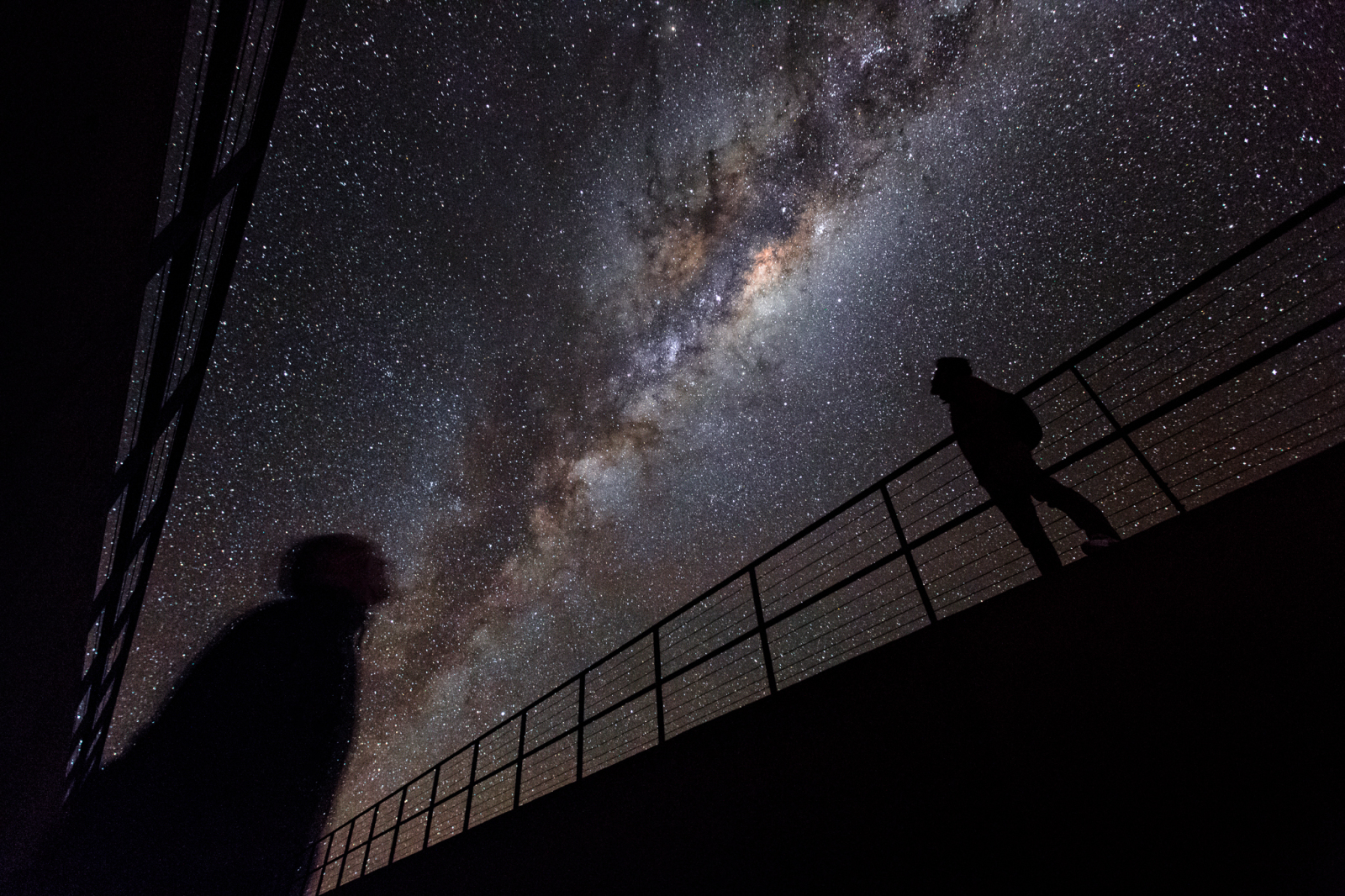 years - what is our universe made of? When physicists look out into space, they're confronted with a mystery: the material or matter we can see makes up only about 5% of the mass that we know must be out there. The other 95% is totally invisible to us, and so scientists refer to it as dark. At least 20% of the mass out there is what we call Dark Matter. But if it's invisible, how do we know it's out there? University College London cosmologist Andrew Pontzen explained to Chris Smith...
years - what is our universe made of? When physicists look out into space, they're confronted with a mystery: the material or matter we can see makes up only about 5% of the mass that we know must be out there. The other 95% is totally invisible to us, and so scientists refer to it as dark. At least 20% of the mass out there is what we call Dark Matter. But if it's invisible, how do we know it's out there? University College London cosmologist Andrew Pontzen explained to Chris Smith...
Andrew - Well, we can kind of take a census of what's out there in the universe and we do that by making indirect measurements. So for instance, you might measure how fast things are moving around and one of the famous measurements of this was made by Fritz Zwicky. He was looking in clusters of galaxies and measuring how fast the galaxies within that were moving around relative to each other.
He found that they were zooming around really fast. So fast, that that galaxy cluster would simply fall apart unless there was something sticking it together. And so, his explanation for that was, there must be some extra stuff in there with an extra pull of gravity, serving that purpose of gluing the galaxy clusters together. And since then we've seen this phenomenon all over the place
Chris - Because we know how things should move when gravity acts on them. When we make observations of things in the universe, we're seeing them moving at the wrong speed for they're not to be more mass there, more gravitational acting material than we can actually see and that's what we're calling dark matter.
Andrew - That's right. So, it builds on how we know gravity works and thanks to Newton and then later Einstein, we think we kind of have that pinned down. We think we know how gravity works and then this idea that there has to be extra stuff follows.
Chris - And when you take the estimates that people have made it, looks like it sums to about a fifth of the mass.
Andrew - Yeah. It's got to be something like that.
Chris - So, it's pretty prolific. Where is it distribute in the universe? Is there dark matter in this room with us?
Andrew - Yup! If we're right, there certainly is dark matter in this room, zipping through really fast., it has to be said. It doesn't clump together in the same concentrated waya normal matter does. So, the Solar System and everything within it - the Earth and the sun, and everything in this room is stuck together by forces that dark matter doesn't seem to feel. So, as a result, it's much more spread-out through the universe and it's zipping through the room at the moment maybe at hundreds of kilometres every second.
Chris - So, what physically might it be?
Andrew - Well, we think it's got to be some kind of extra fundamental particle. Particles are the things that make up normal matter. In fact, we talk about particles when we're talking about say, protons and neutrons, and electrons, the things that we know make up atoms and then make up the familiar world. So, we think there's an extra type of particle that as yet, hasn't been directly discovered but is out there in the universe.
Chris - Are these the WIMPs that physicists are fond of talking about?
Andrew - That's right. So, that's one particular type of WIMP or weakly interacting massive particle.
Chris - And how might we be able to detect the stuff that we can't see?
Andrew - Well, there are a number of different ways. One way is to try and make it: if you take something like the Large Hadron Collider for example, you can smash particles of normal matter together. We think if you could get to high enough energies in those collisions, occasionally, you'd actually manufacture one of these mysterious new particles. And then actually, you think, how would you find out? How would you know that you manufactured it if it's invisible? And the answer is, you would look for things going missing. You would put in a certain amount of energy and you would sum up everything that you saw come out and realise, something has gone missing. So, you'd know you made something extra. That's one way you could do it.
Another way is to actually go all out and just say, "Well surely, we must be able to detect these things. We must be able to see directly that they're there one way or another." That's what we call direct detection and people are certainly trying to do that as well. It's just really, really challenging because you need to be incredibly sensitive. If we're right about these particles, they so rarely and so weakly interact with normal matter that we're made out of and any detector that we could build would be made out of, that it's a real challenge just to build something that can do that.
Chris - And that's the reason they're invisible because they just don't interact with stuff.
Andrew - Exactly. In fact, when we say dark matter, it's almost a bit of a bad name because the stuff isn't actually dark. It's just transparent because exactly like you say, simply not interacting with stuff, except through its pull of gravity.
Chris - Does that mean that they're interacting with the other thing that's been big news in recent years, the Higgs Boson, which CERN made a great climax about announcing? They think they have discovered this particle that appears to add mass to things. Does that mean that these dark matter particles are in some way bound up with Higgs Bosons?
Andrew - Certainly what's true is that the Higgs Boson would feel the gravitational pull of a dark matter particle and vice versa. That's got to be true, but what we don't know is just how bound up are these two things. Could it be the case, for instance, that the Higgs Boson - when they start to probe its properties in more detail - the Large Hadron Collider - could it be that it points the way to understanding of where dark matter is coming from? Well, it could be but we just don't know at the moment.
Chris - Because I was going to say, the standard model, which is this jigsaw puzzle of how we think matter is constructed and what the particles are that give rise to matter, when the Higgs Boson came along, people said, "right. Look, that's the missing piece." Well now, we've got this extra piece in the puzzle, the dark matter particle, where does that go in a puzzle that's full then?
Andrew - . Within the standard model, there are certainly conundrums...
Chris - Then it's conundra.
Andrew - I'm sorry. I forgot that that's in Cambridge. Yes, there are certainly conundra within the puzzle and those conundra, as we try to start to answer them, for instance, how does - what we know about particle physics on very small scales, fit together with how we know the universe works on very large scales - this just doesn't fit together at the moment. It's as people try to work out how all that fits together, that they realise, "Okay, looks like we've got to have these extra particles."
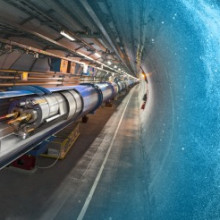
31:27 - Are Higgs Bosons the key to dark matter?
Are Higgs Bosons the key to dark matter?
with Dr Matthew Mccullough, CERN & Will Kalderon, Oxford University
 The Large Hadron Collider - or LHC - in Geneva is the world's most powerful particle accelerator. It's now in the process of being switched back on after a two-year upgrade that will allow it to smash together the positive particles in atoms, called protons, at higher energies than ever before. Scientists are hoping that, when they do this, they'll be able to make dark matter, giving them a chance to study it directly for the first time. Graihagh Jackson went to meet LHC physicist Matthew McCullough to hear how...
The Large Hadron Collider - or LHC - in Geneva is the world's most powerful particle accelerator. It's now in the process of being switched back on after a two-year upgrade that will allow it to smash together the positive particles in atoms, called protons, at higher energies than ever before. Scientists are hoping that, when they do this, they'll be able to make dark matter, giving them a chance to study it directly for the first time. Graihagh Jackson went to meet LHC physicist Matthew McCullough to hear how...
Matthew - Underneath our feet is a very large tunnel that contains one of the biggest experiments that's ever been constructed. Within this tunnel is contained the Large Hadron Collider otherwise known as the LHC. In the Large Hadron Collider, protons are smashed together at extremely high energies, very close to the speed of light. We do that here at CERN in order to try and better understand the universe.
Graihagh - So, protons are actually whizzing underneath our feet right now as we speak.
Matthew - Absolutely and whenever the protons hit head-on, these extraordinary events - we call them - where large numbers of particles are produced and they are detected and measured by these extremely large detectors. One of them is CMS and the other one is the atlas detector.
Graihagh - So, why are we doing this? Why are we creating these sort of events as you call them?
Matthew - Well, the goal is to try and understand other aspects of fundamental physics. So, we have this theory called the standard model. This theory predicts all sorts of things that we observe in nature. One of those things is the Higgs Boson but there are the puzzles beyond the standard model that we don't understand. One of those is dark matter. So, one hope for the LHC is that by smashing together these protons, we might be able to produce dark matter particles and then try and understand something about the nature of dark matter.
Graihagh - How does smashing together two protons equal dark matter? Proton plus proton equals dark matter. It doesn't add up in my head but perhaps it does in yours.
Matthew - One good way of understanding this is to use this famous equation by Einstein, E=mc2. So, (E) is the energy in for example, a particle collision. (m) is the mass of the particles that you can create and (c) is the speed of light. By smashing together protons at the LHC at very, very high energies, you might produce pairs of dark matter particles. For example, one way that dark matter could be produced at the LHC is that even the Higgs Boson could decay into dark matter. So, you could have one of these collisions produce a Higgs Boson and then that Higgs Boson actually decays into dark matter. So, you don't see, you never see the Higgs Boson and you never see the decay happening, and this dark matter flies out of the detector.
Graihagh - So a proton hits a proton, they collide and Higgs Boson was created and that will create dark matter. That dark matter disappears undetected. Is that correct?
Matthew - Absolutely.
Graihagh - You're probably wondering how, if a newly created dark matter particle flies out of the detector undetected, how on Earth we can a.) know it's there and b.) learn anything about it? I put this to Will (Calderon), physicist at Oxford University who's been working on just this conundrum.
Will - So, right now, we're standing outside the atlas control room. Actually, with very good timing because right now, it's the first 13 TEV collisions ever. These first collisions are at the highest energies that humans have ever collided particles and will be used to calibrate the machine and the detectors to get it in the best shape ready for - well, when we start the real physics in the summer.
Graihagh - The real physics. I mean, looking at what's in front of us now, it does look like real physics is happening. There are perhaps 30 people, all avidly tapping away on their computers whilst there are some huge projections of all sorts of particles scattering and various simulations going on. No doubt, in a couple of weeks, when all the tests and configurations are done, you will be in there.
Will - Yeah, really soon. Actually, it's happening in less than a month now until we get the actual collisions that we'll, from which maybe we'll get hints of dark matter and new physics and who knows what.
Graihagh - Does that mean you'll be able to potentially hold the dark matter particle in your hand?
Will - I wish, but sadly, by their very nature, you can't hold them. They don't interact with us at all.
Graihagh - If you can't see it, you can't hold it, how on Earth do you go about detecting it?
Will - We look for this indirectly. So, we know that we have two protons flying towards each other. What we do then is, of this spray of everything flying out, we add up the momenta in all the different directions. So, if we imagine each particle as being a little arrow and the length of the arrow is its momentum, we stick all those arrows end to end, and they make a big wiggly line that comes back on itself. If that line doesn't come back on itself, that means momentum has not been conserved. One of the explanations that that could be is that there is a particle that has escaped our detection and that particle could be dark matter.
Graihagh - So essentially, you're looking for missing energy and that missing energy will have been stolen away by a dark matter particle.
Will - Exactly.
Graihagh - So, now that you've seen this missing energy, and you think you might have witnessed the dark matter particle being created, what can you actually infer about it? What can you tell about its properties?
Will - It's really a statistics game. We need to see lots of them before we can say anything conclusive. But you can tell things like the mass of this particle and what kind of things it interacts with.
Graihagh - I was going to say, so you can tell quite a lot then just from one - I say, one simple collision - a few collisions and I suppose they're not even all that simple either. You can start to build up a picture of what it is.
Will - Yeah, exactly. So, if we see something hopefully, it will progress as much as the Higgs discovery did.
Graihagh - It took 50 years to find the Higgs. When might we finally see a dark matter particle?
Will - Well, we have all the experience from the Higgs hunt. So, it could be that with this jump in energy, we can suddenly produce these dark matter particles in a sense it's up to the universe. We don't know what it's made of. If it's made of the right kind of things, maybe by the end of the summer, if it's made of the wrong kind of things, who knows.
Graihagh - Oxford's Will Kalderon and before him CERN's Matthew McCulloch.

37:42 - Dark Matter detector looking for WIMPs
Dark Matter detector looking for WIMPs
with Dr Cham Ghag, UCL
Firing protons at each other to create dark matter may be one way of figuring out  what this elusive substance is, but another is by detecting the dark matter particles that we believe must be bombarding us every second. But how do we do this? Last month, UK scientists were awarded a grant to build the biggest dark matter detector yet! It's called LZ - short for Lux Zeplin - and it will buried deep underground in the US. Scientists like UCL's Dr Cham Ghag, who's one of the researchers involved with the project, hope to start seeing results by 2021, as he explained to Chris Smith...
what this elusive substance is, but another is by detecting the dark matter particles that we believe must be bombarding us every second. But how do we do this? Last month, UK scientists were awarded a grant to build the biggest dark matter detector yet! It's called LZ - short for Lux Zeplin - and it will buried deep underground in the US. Scientists like UCL's Dr Cham Ghag, who's one of the researchers involved with the project, hope to start seeing results by 2021, as he explained to Chris Smith...
Cham - So, the LUX Zeplin or LZ experiment will be going about a kilometre and a half under the surface in the black hills of South Dakota.
Chris - When you say deep underground, what's actually there? Is it like a mine or something?
Cham - It is. It was a former gold mine. All the mining corporations have ended and now, it's a dedicated science laboratory with a couple of experiments, there ready.
Chris - Why go to the lengths of being 1.5 kilometres underground to do these experiments?
Cham - These sorts of experiments have to be made from low radioactivity materials. And that's because we're really looking for a needle in a haystack and we want to make their haystack as small as we can because all materials carry some trace amount of radioactivity.
There's a lot of that about on the surface of the Earth in particular. We're bombarded from space with cosmic rays and so, to get away from those, and the first line of defence, against all these radioactivity that's out there within which we're trying to find the faintest signals from dark matter, we go deep underground. And that really shields us from cosmic rays in particular.
Chris - What, in fact, is the detector your building? How will it work?
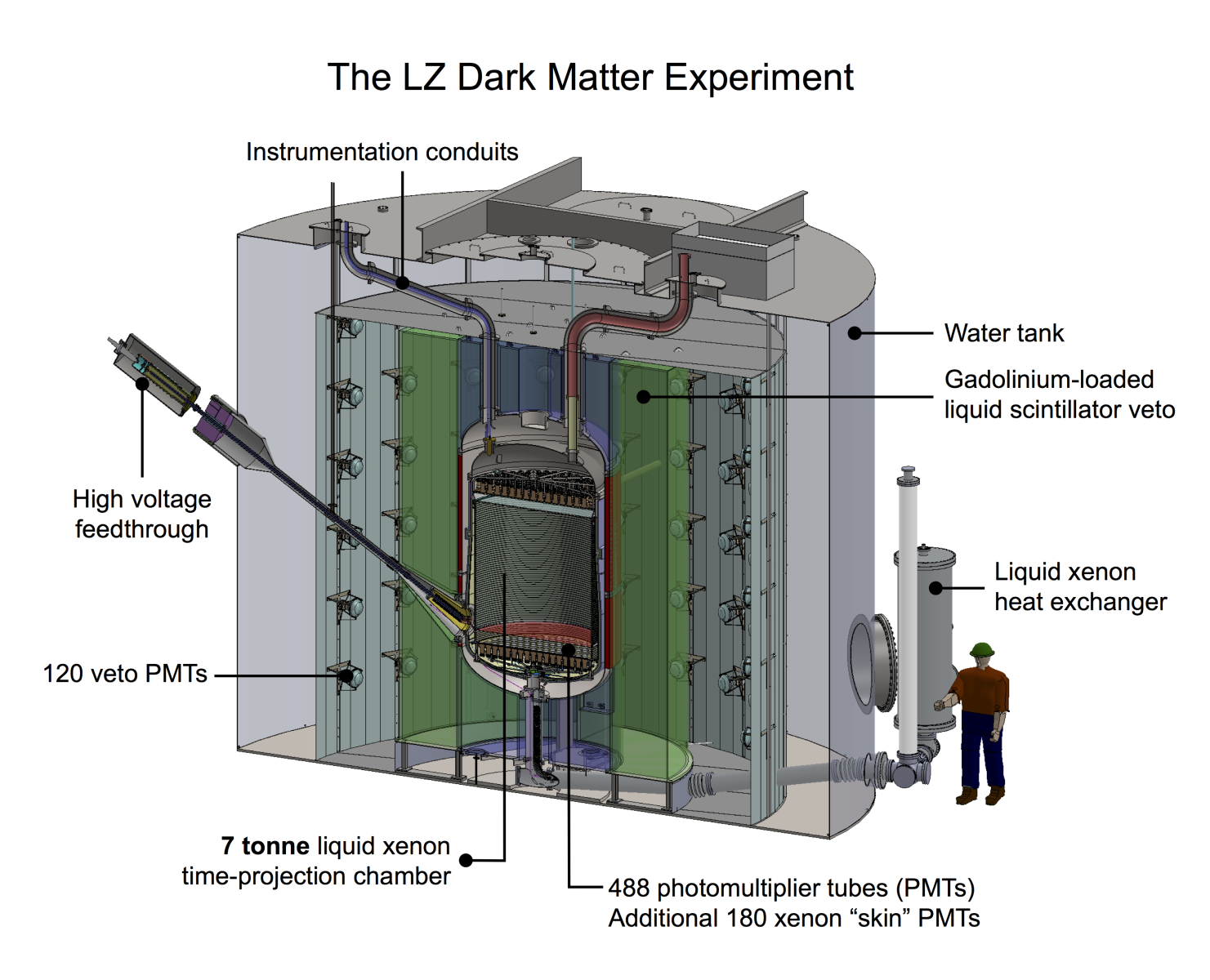 Cham - So, the detector is configured in a Russian doll set up where the first line of defence is the earth itself. It's 1.5 kilometres of rock above us. But then once we're down into the underground laboratory, we have a giant water tank that shields the detector within from radiation that's coming from the rock and the laboratory in the sort of ambient environment. And then within that, we have the primary LUX Zeplin instrument itself which is essentially a tank of liquid xenon.
Cham - So, the detector is configured in a Russian doll set up where the first line of defence is the earth itself. It's 1.5 kilometres of rock above us. But then once we're down into the underground laboratory, we have a giant water tank that shields the detector within from radiation that's coming from the rock and the laboratory in the sort of ambient environment. And then within that, we have the primary LUX Zeplin instrument itself which is essentially a tank of liquid xenon.
Chris - Why do you need xenon?
Cham - So, xenon is a very efficient scintillator, which is to say that if you have something give a xenon atom a glancing blow, although it will only move sort of just a tiny fraction of a millimetre, this tiny energy that's been deposited in the xenon, it produces just a handful, just a few flashes of - well, one flash with a few photons of light. And so, we're detecting the light and the charges that's liberated from xenon when it's had anything interact with it.
Chris - How frequently do we expect that to happen, when your detector is running, how many particles, how many opportunities in a day let's say, are they going to be to see this happening?
Cham - Well, there are two things that we don't know and that's the mass of this WIMP particle and the interaction cross section which is to say, we don't know how likely it is to actually interact with an atom. This dark matter interacts so infrequently that we're only really expecting a few handfuls of events, after a couple of years of running.
Chris - Is there anything else that could look like a dark matter particle and fool you into thinking you're seeing one but you're not, you're seeing something else entirely.
Cham - Yes. Neutrons in particular are a troublesome background. They're sort of a blessing and a curse in that we use neutrons to calibrate our detectors to say, "Okay, if dark matter did hit, what would it look like?"
That's because neutrons produce signatures very similar to WIMPs. But neutrons can be separated from dark matter: The detectors are so large that any neutron that does get in, is likely to bounce around a few times. In contrast, the dark matter particle, we're lucky if we see it hit an atom in the first place. It's really not going to interact again within the detector.
So, single interactions mean dark matter. Multiple means neutrons.
Chris - If you do see some collisions, what will you be able to deduce?
Cham - The number of events that we detect will tell us about the cross section for a dark matter particle to actually interact with a regular atom. And so, that gives us a very nice handle on the interaction with standard model particles.
On top of that, the energy distribution of the events that we do see, that tells us about the mass of the particle itself. So, if we have events that are really quite high energy, that corresponds to the dark matter particle itself being quite a massive particle. If they're all bunched towards very low energies, that tells us that the dark matter particle is a low mass or light WIMP.
Chris - You're the latest in a sequence of these sorts of detectors for dark matter particles. Why have your forebears failed and why do you think this experiment is going to be different?
Cham - All of these experiments have been pushing the envelopes, getting deeper and deeper into unexplored parameters based. So, they haven't seen dark matter but that's because nature hasn't been that kind. We've needed to get more sophisticated, larger, more sensitive essentially, in our searches and get deeper and deeper.
And so, far from previous experiments failing, we've been developing the technology to get to the size of detectors or a scale of many tons of target, and with the low energy thresholds so that we can see the rarest, tiniest of interactions.
And so, we're hoping that now, we have the technological readiness to really get down into where we hope the dark matter lives.

43:38 - The end of darkness?
The end of darkness?
with Dr Kathryn Freese, NORDITA
Scientists have been looking for Dark Matter since Fritz Zwicky theorised it nearly 100 years ago! And whilst scientists have developed clever way that we could detect it, we're not much further forward that Zwicky: We don't know what it is, we don't know where it came from, and at a fundamental level, we're still figuring out what dark matter is and isn't. So why continue? Why is finding dark matter still so important? Graihagh Jackson put these questions to Dr Kathryn Freese, physicist from NORDITA...
Katherine - The dark matter problem is almost 100 years old. So, this is maybe the longest outstanding problem in all of modern physics. So, this is a big one and we really want to nail it. The good news is that we have ideas for what it could be and we think that discovery is around the corner. So, I'm predicting in the next 10 years that we'll know.
Graihagh - That's the good news.
Katherine - That's the good news.
Graihagh - What don't we know? What's the bad news?
Katherine - Well, the only thing we really know is that it has some kind of gravitational pull, It yanks things around, You can see a lot of that going on, but we don't know what it's made of. The fear in the back of our minds is always, what if we're just really heading in the wrong direction? What if we are just completely missing the point?
Graihagh - If we are wrong, that sounds like a pretty scary idea because surely, this underpins many phenomenon we observe in the universe.
Katherine - Yeah. Well, so, the nightmare scenario is - let's go back to Aristotle and Ptolemy where they had the idea that everything is revolving around Earth. But the picture was kind of all wrong and it took thousands of years to correct that. So, our worst nightmare is we're somehow making an epicycle mistake and that some brilliant kid - I don't know - 20 years from now or 50 years from now is going to come along and say, "Hey, rethink this entirely". If it's 50 years from now, I won't be around. So, that's the worst nightmare, the worst fear. But the reason I say I don't believe that about dark matter is because we have so many pieces of evidence from so many different directions that it would be very hard to explain in terms of anything else. So, I'm pretty convinced about the dark matter that it's real.
Graihagh - You say you're pretty confident that we'll be able to find it in 10 years time, what makes you so confident that that's a possibility?
Katherine - We have really good candidates, these WIMPs and we have experiments that are doing a really good job of searching for them. In fact, I played a role in pioneering these studies in the first place and that was 25 years ago. We did some calculations if the WIMPs that are in the galaxy, the calculations of how they interact with ordinary matter and we made predictions for what the detector might be able to see. In fact, because of our work, they started building these detectors all over the world, these underground direct detection experiments. And the sensitivity that we initially said you have to have is, wow! They are a thousand times better at this point than we ever imagined they would be. So, these experiments are getting really good! They're really sensitive! And some of them are seeing strange anomalous results. I don't know. Maybe that's nothing. Maybe it's just background, but I'm hoping that there's something to some of these strange anomalies and maybe they're hinting that we're resolving this problem. So, I guess I believe in this type of candidate as being really well-motivated. The experiments are really capable at this point of seeing something and some of them maybe already are. So, I'm hopeful for the near future.
Graihagh - Given that there is so much evidence for it and it would obviously be a very exciting prospect to find it - 100 years in the making - how would it affect our knowledge of the universe?
Katherine - So, imagine the ancients be ancient Greek, go back to cave days. They must've wondered what is out there. I mean, that's what makes us humans. That's who we are as a species. We're curious and we want to understand our surroundings. That's why we've been successful as a species. So, I think this is kind of the burning desire to understand - my God! - the bulk of what is around us, the bulk of the universe. So, I think answering this big giant question, that's revolutionary and that's super important all by itself.
Now, on the practical side of things and this is why they pay us, it's likely that there will be some consequences for our daily lives. Traditionally, science is funded at the fundamental level because people think there can be serendipitous discovery of something that will change society. That could happen either from the detectors. In building the detectors, you might find some new technology that is really important for, I don't know, curing cancer or something. Who knows? Or once we know what the dark matter is, I don't know what the consequences will be. Will we get some new kind of heat source better than sending more carbon dioxide up there? so, the beauty of fundamental science is that it's intrinsically important. It's intrinsically interesting, but it also tends to change our lives.

Could I land on a gassy planet like Jupiter?
Heather Douglas put this to Dr Marc Rayman from NASA's Jet Propulsion Lab to see if he could clear the air...
Alanna - If I landed on a gassy planet, would I sink to the core?
Heather - Our Solar System has a whole host of different planet types. Some made of rock like, earth others of ice like Pluto and others made of gas like Jupiter. But what would happen if I were to travel past Mars, weave through the asteroid belt, and try to land on the gas giant? I spoke to Dr. Mark Raymen who works at NASA's jet propulsion lab.
Marc - Although some planets seem to be gassy, they aren't like the light, airy, and substantial gas we generally think of. On Earth, the weight of the air above you pulled down by our planet's gravity creates a modest pressure. This is about 1 kilogram per square centimetre. That's the mass of a big book, like a dictionary if you remember those from the 20th century, pushing down on an area about the size of a single Lego brick. We conveniently call it 1 bar.
Heather - That's Earth, but what about Jupiter?
Marc - In contrast to our planet, gas planets are composed mostly of gas. They're also gigantic and the weight of all that gas is tremendous. For example, Jupiter is mostly hydrogen and it is enormous, 11 times the diameter of Earth and over 300 times the mass. It may have a rocky core that's more than 10 times the mass of Earth. All that mass causes intense gravity, pulling downward on the gas which compresses it and creates fantastically high pressure.
Heather - More pressure than one dictionary, how many though? A hundred? A thousand? Ten thousand?
Marc - If you ever tried to land on a gassy planet, you would be subjected to pressure beyond anything you can imagine. As you descended below the colourful gas clouds, the pressure would grow and grow, rising to 1 million bar, at a depth of about 10,000 kilometres.
Heather - One million dictionaries.
Marc - You would be immersed in a sea of hydrogen so dense that it's more like liquid than gas. At 20,000 kilometres, the pressure is around 2 million bars. That's 2,000 times greater than the highest pressure found on Earth in the Mariana Trench in the deepest part of the Pacific Ocean.
Heather - Two million dictionaries.
Marc - The hydrogen is compressed so hard that the electrons are squeezed off. The strange condition makes the hydrogen metallic, but going still deeper, the pressure would continue to skyrocket, exceeding perhaps 40 million bars at the rocky core, more than 60,000 kilometres deep.
Heather - Forty million dictionaries.
Marc - If you ever tried to land on a gassy planet, you would not even make it to a few hundred kilometres. Your spacecraft,and you, would be utterly destroyed, squashed by the crushing atmospheric pressure, long before you found the core. So, you might sink to the core, but only in the form of squished atoms.
Heather - I don't think I'll be going to Jupiter after all. Thanks for clearing the air on this one, Marc. Next week, we're sequencing Lorianna's question.
Lorianna - I was wondering why the mother doesn't reject a baby because it has a different genetic sequence.









Comments
Add a comment